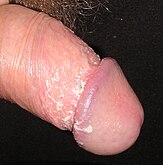Smegma
Smegma(fromAncient Greekσμῆγμα,smêgma,'soap')[1]is a combination ofshedskin cells,skin oils, and moisture. It occurs in both male and femalemammalian genitalia.In females, it collects around theclitorisand in the folds of thelabia minora;in males, smegma collects under theforeskin.
Females
[edit]
The accumulation ofsebumcombined with dead skin cells forms smegma.Smegma clitoridisis defined as the secretion of theapocrine glandsof the clitoris (sweat) and the sebaceous glands of the clitoris (sebum) in combination withdesquamatingepithelial cells.[2]Glands that are located around the clitoris, the labia minora, and the labia majora secretesebum.
If smegma is not removed frequently it can lead to clitoral adhesion which can make clitoral stimulation (such as masturbation) painful (clitorodynia).[3][4][5][6]
Males
[edit]
In males, smegma helps keep theglansmoist and facilitatessexual intercourseby acting as a lubricant.[7][8][9]
Smegma was originally thought to be produced bysebaceous glandsnear thefrenulumcalledTyson's glands;however, subsequent studies have failed to find these glands.[10]Joyce Wright states that smegma is produced from minute microscopic protrusions of the mucosal surface of the foreskin and that living cells constantly grow towards the surface, undergo fatty degeneration, separate off, and form smegma.[7]Parkashet al.found that smegma contains 26.6% fats and 13.3% proteins, which they judged to be consistent with necrotic epithelial debris.[10]
Newly produced smegma has a smooth, moist texture. It is thought to be rich insqualene[11]and contain prostatic and seminal secretions, desquamatedepithelial cells,and the mucin content of theurethral glands of Littré.[9]Smegma containscathepsin B,lysozymes,[12]chymotrypsin, neutrophil elastase andcytokines,which aid the immune system.[13]
According to Wright, the production of smegma, which is low in childhood, increases from adolescence until sexual maturity when the function of smegma for lubrication assumes its full value. From middle-age, production starts to decline and in old age virtually no smegma is produced.[7]Jakob Øster reported that the incidence of smegma increased from 1% among 6- to 9-year-olds to 8% among 14- to 17-year-olds (amongst those who did not present withphimosisand could be examined).[14]
Clinical significance and hygiene
[edit]The production of smegma, which increases during puberty, can only be of limited significance, as males and females learn to practice good genital hygiene.[14]
Men with smegma can cause irritation and inflammation, which can increase the risk ofpenile cancer.In the past some experts used to be concerned smegma itself might cause cancer.[15]
Other animals
[edit]In healthy animals, smegma helps clean and lubricate the genitals. In veterinary medicine, analysis of this smegma is sometimes used for detection of urogenital tract pathogens, such asTritrichomonas foetus.[16]Accumulation of smegma in theequinepreputial foldsand theurethral fossaandurethral diverticulumcan form large "beans" and promote the carriage ofTaylorella equigenitalis,the causative agent ofcontagious equine metritis.[17]Some equine veterinarians have recommendedperiodic cleaning of male genitalsto improve the health of the animal.[18]
See also
[edit]- Keratin pearl
- List of cutaneous conditions
- Mycobacterium smegmatis– found in smegma
References
[edit]- ^"smegma".Merriam-Webster.com Dictionary.Merriam-Webster.Retrieved2017-03-02.
- ^ "Medical Dictionary".Medilexicon.
- ^Aerts, Leen; Rubin, Rachel S.; Randazzo, Michael; Goldstein, Sue W.; Goldstein, Irwin (June 2018)."Retrospective Study of the Prevalence and Risk Factors of Clitoral Adhesions: Women's Health Providers Should Routinely Examine the Glans Clitoris".Sexual Medicine.6(2): 115–122.doi:10.1016/j.esxm.2018.01.003.PMC5960030.PMID29559206.
- ^Rubin, Rachel; Minton, Julea; Gagnon, Catherine; Winter, Ashley; Goldstein, Irwin (April 2017). "PD25-02 Taking Responsibility for Female Prepucial Disorders: Urologic Management of Phimosis-Based Clitorodynia".Journal of Urology.197(4S).doi:10.1016/j.juro.2017.02.1197.S2CID78573467.
- ^Parada, Mayte; D'Amours, Tanya; Amsel, Rhonda; Pink, Leah; Gordon, Allan; Binik, Yitzchak M. (August 2015). "Clitorodynia: A Descriptive Study of Clitoral Pain".The Journal of Sexual Medicine.12(8): 1772–1780.doi:10.1111/jsm.12934.PMID26104318.
- ^Shafik, A. (November 2000). "The Role of the Levator Ani Muscle in Evacuation, Sexual Performance and Pelvic Floor Disorders".International Urogynecology Journal.11(6): 361–376.doi:10.1007/pl00004028.PMID11147745.S2CID29636705.
- ^abc Wright J (September 1970)."How smegma serves the penis: Nature's assurance that the uncircumcised glans penis will function smoothly is provided by smegma".Sexology.37(2): 50–53.
- ^ Van Howe RS, Hodges FM (October 2006)."The carcinogenicity of smegma: debunking a myth".Journal of the European Academy of Dermatology and Venereology.20(9): 1046–1054.doi:10.1111/j.1468-3083.2006.01653.x.PMID16987256.S2CID22840346.
- ^ab Fleiss PM, Hodges FM, Van Howe RS (October 1998)."Immunological functions of the human prepuce".Sexually Transmitted Infections.74(5): 364–367.doi:10.1136/sti.74.5.364.PMC1758142.PMID10195034.
- ^ab Parkash S, Jeyakumar S, Subramanyan K, Chaudhuri S (August 1973)."Human subpreputial collection: its nature and formation".Journal of Urology.110(2): 211–212.doi:10.1016/s0022-5347(17)60164-2.PMID4722614.
- ^ O'Neill HJ, Gershbein LL (1976). "Lipids of human and equine smegma".Oncology.33(4): 161–166.doi:10.1159/000225134.PMID1018879.
- ^ Frohlich E, Schaumburg-Lever G, Klessen C (1993). "Immunelectron microscopic localization of cathepsin B in human exocrine glands".Journal of Cutaneous Pathology.20(1): 54–60.doi:10.1111/j.1600-0560.1993.tb01250.x.PMID8468418.S2CID1326013.
- ^ Chukwuemeka Anyanwu LJ, Kashibu E, Edwin CP, Mohammad AM (2012). "Microbiology of smegma in boys in Kano, Nigeria".Journal of Surgical Research.173(1): 21–25.doi:10.1016/j.jss.2011.04.057.PMID21872267.
- ^ab
Oster J (April 1968)."Further fate of the foreskin. Incidence of preputial adhesions, phimosis, and smegma among Danish schoolboys".Archives of Disease in Childhood.43(228): 200–3.doi:10.1136/adc.43.228.200.PMC2019851.PMID5689532.
The production of smegma increases from the age of 12-13, but our actual figures of the incidence of smegma can only be of limited significance, as the boys received regular instruction about preputial hygiene.
- ^"Risk Factors for Penile Cancer".American Cancer Society.25 June 2018.
- ^ Chen XG, Li J (2001). "Increasing the sensitivity of PCR detection in bovine preputial smegma spiked withTritrichomonas foetusby the addition of agar and resin ".Parasitology Research.87(7): 556–558.doi:10.1007/s004360100401.PMID11484853.S2CID7671511.
- ^Primary Industries Ministerial Council of Australia and New Zealand (2002).Disease strategy: Contagious equine metritisArchived2008-07-21 at theWayback Machine(Version 1.0). In: Australian Veterinary Emergency Plan (AUSVETPLAN), Edition 3, PIMCANZ, Canberra, ACT.
- ^Lowder, Michael (1 September 2001)."A Clean Sheath Is A Healthy Sheath".Horse City.Archived fromthe originalon 14 September 2005.
External links
[edit]- Neubert, U; Lentze, I (March 1979). "Die bakterielle Flora des Präputialraumes" [The bacterial flora of preputial space].Hautarzt(in German).30(3): 149–153.PMID35486.
- Marzuillo, Pierluigi; Guarino, Stefano; Furlan, Daniela; Pecoraro, Anna; Pedullà, Marcella; Miraglia del Giudice, Emanuele; La Manna, Angela (October 2018). "Cleaning the genitalia with plain water improves accuracy of urine dipstick in childhood".European Journal of Pediatrics.177(10): 1573–1579.doi:10.1007/s00431-018-3215-x.PMID30054720.S2CID51726930.
- Fahmy, Mohamed A. Baky (2020). "Smegma".Normal and Abnormal Prepuce.pp. 153–161.doi:10.1007/978-3-030-37621-5_17.ISBN978-3-030-37620-8.S2CID243171662.
